| Revision as of 22:37, 2 December 2020 editMonkbot (talk | contribs)Bots3,695,952 editsm Task 18 (cosmetic): eval 33 templates: del empty params (9×);Tag: AWB← Previous edit | Revision as of 15:19, 14 January 2021 edit undoMonkbot (talk | contribs)Bots3,695,952 editsm Task 18 (cosmetic): eval 33 templates: hyphenate params (13×);Tag: AWBNext edit → | ||
| Line 1: | Line 1: | ||
| {{short description|Misplaced Pages list article}} | {{short description|Misplaced Pages list article}} | ||
| This '''list of nearest terrestrial exoplanet candidates''' contains possible ] ("rocky") ]s spaced at a distance of up to 50 ]s from the ], ordered by increasing distance.<ref name=aaa534>{{citation | display-authors=1 | last1=Pepe | first1=F. | last2=Lovis | first2=C. | last3=Ségransan | first3=D. | last4=Benz | first4=W. |last5=Bouchy | first5=F. | last6=Dumusque | first6=X. | last7=Mayor | first7=M. | last8=Queloz | first8=M. | last9=Queloz | first9=D. | last10=Udry | first10=S. |title=The HARPS search for Earth-like planets in the habitable zone: I – Very low-mass planets around HD20794, HD85512 and HD192310 | journal=Astronomy & Astrophysics | volume=534 | pages=A58 | date=2011 | arxiv=1108.3447 | bibcode=2011A&A...534A..58P | doi=10.1051/0004-6361/201117055 }}</ref><ref name=epe_HD_20794>{{citation | first1=Jean | last1=Schneider | publisher=Paris Observatory | title=Star: HD 20794 | work=Extrasolar Planets Encyclopaedia |url=http://exoplanet.eu/star.php?st=HD+20794 | |
This '''list of nearest terrestrial exoplanet candidates''' contains possible ] ("rocky") ]s spaced at a distance of up to 50 ]s from the ], ordered by increasing distance.<ref name=aaa534>{{citation | display-authors=1 | last1=Pepe | first1=F. | last2=Lovis | first2=C. | last3=Ségransan | first3=D. | last4=Benz | first4=W. |last5=Bouchy | first5=F. | last6=Dumusque | first6=X. | last7=Mayor | first7=M. | last8=Queloz | first8=M. | last9=Queloz | first9=D. | last10=Udry | first10=S. |title=The HARPS search for Earth-like planets in the habitable zone: I – Very low-mass planets around HD20794, HD85512 and HD192310 | journal=Astronomy & Astrophysics | volume=534 | pages=A58 | date=2011 | arxiv=1108.3447 | bibcode=2011A&A...534A..58P | doi=10.1051/0004-6361/201117055 }}</ref><ref name=epe_HD_20794>{{citation | first1=Jean | last1=Schneider | publisher=Paris Observatory | title=Star: HD 20794 | work=Extrasolar Planets Encyclopaedia |url=http://exoplanet.eu/star.php?st=HD+20794 | access-date=2011-12-05 }}</ref><ref name="tuomi12">{{Cite journal|last= Tuomi, Anglada-Escude, Gerlach, Jones, Reiners, Rivera, Vogt, Butler|first= Mikko, Guillem, Enrico, Hugh R. R., Ansgar, Eugenio J., Steven S., R. Paul|arxiv= 1211.1617|title= Habitable-zone super-Earth candidate in a six-planet system around the K2.5V star HD 40307|journal= Astronomy & Astrophysics|volume= 549|pages= A48|date= 2012|last2= Anglada-Escude|first2= Guillem|last3= Gerlach|first3= Enrico|last4= Jones|first4= Hugh R. R.|last5= Reiners|first5= Ansgar|last6= Rivera|first6= Eugenio J.|last7= Vogt|first7= Steven S.|last8= Paul Butler|first8= R.|doi= 10.1051/0004-6361/201220268|bibcode=2013A&A...549A..48T}}</ref> | ||
| They may be composed primarily of ] ]s and/or ]s. Within the Solar System, the terrestrial planets are the ] closest to the ]. | They may be composed primarily of ] ]s and/or ]s. Within the Solar System, the terrestrial planets are the ] closest to the ]. | ||
| Line 8: | Line 8: | ||
| This list is incomplete, currently containing 34 exoplanets, 11 of which probably lie inside their star's ]. | This list is incomplete, currently containing 34 exoplanets, 11 of which probably lie inside their star's ]. | ||
| There are roughly 2,000 stars at a distance of up to 50 light-years from the Solar System<ref>{{cite web|url=http://www.atlasoftheuniverse.com/50lys.html|title=Stars within 50 light years| |
There are roughly 2,000 stars at a distance of up to 50 light-years from the Solar System<ref>{{cite web|url=http://www.atlasoftheuniverse.com/50lys.html|title=Stars within 50 light years|access-date=3 October 2015}}</ref> (64 of them are yellow-orange ] like our sun<ref>{{cite web|url=http://www.solstation.com/stars3/100-gs.htm|title=G stars within 100 light-years|access-date=3 October 2015}}</ref>). As many as 15% of them can have Earth-sized planets in the habitable zones.<ref name="arxiv.org">{{Cite journal|arxiv=1403.0430|title= Bayesian search for low-mass planets around nearby M dwarfs. Estimates for occurrence rate based on global detectability statistics|journal= Monthly Notices of the Royal Astronomical Society|volume= 441|issue= 2|pages= 1545–1569|last1= Tuomi|first1= Mikko|last2= Jones|first2= Hugh R. A.|last3= Barnes|first3= John R.|last4= Anglada-Escudé|first4= Guillem|last5= Jenkins|first5= James S.|year= 2014|doi= 10.1093/mnras/stu358|bibcode = 2014MNRAS.441.1545T }}</ref> | ||
| On November 4, 2013, astronomers reported, based on ] data, that there could be as many as 40 billion ] ] orbiting in the ]s of ] stars and ] stars within the ] galaxy.<ref name="NYT-20131104">{{cite news |last=Overbye |first=Dennis|title=Far-Off Planets Like the Earth Dot the Galaxy|url=https://www.nytimes.com/2013/11/05/science/cosmic-census-finds-billions-of-planets-that-could-be-like-earth.html |date=November 4, 2013 |work=] | |
On November 4, 2013, astronomers reported, based on ] data, that there could be as many as 40 billion ] ] orbiting in the ]s of ] stars and ] stars within the ] galaxy.<ref name="NYT-20131104">{{cite news |last=Overbye |first=Dennis|title=Far-Off Planets Like the Earth Dot the Galaxy|url=https://www.nytimes.com/2013/11/05/science/cosmic-census-finds-billions-of-planets-that-could-be-like-earth.html |date=November 4, 2013 |work=] |access-date=November 5, 2013 }}</ref><ref name="PNAS-20131031">{{cite journal |last1=Petigura |first1=Eric A.|last2=Howard |first2=Andrew W. |last3=Marcy |first3=Geoffrey W. |title=Prevalence of Earth-size planets orbiting Sun-like stars|url=http://www.pnas.org/content/early/2013/10/31/1319909110 |date=October 31, 2013 |journal=]|volume=110|issue=48|pages=19273–19278|doi=10.1073/pnas.1319909110 |access-date=November 5, 2013 |arxiv = 1311.6806 |bibcode = 2013PNAS..11019273P |pmid=24191033 |pmc=3845182}}</ref> Eleven billion of these estimated planets may be orbiting Sun-like stars.<ref name="LATimes-20131104">{{cite news |last=Khan |first=Amina |title=Milky Way may host billions of Earth-size planets |url=http://www.latimes.com/science/la-sci-earth-like-planets-20131105,0,2673237.story |date=November 4, 2013 |work=] |access-date=November 5, 2013 }}</ref> The nearest such planet was then as close as 12 light-years away<ref name="NYT-20131104"/><ref name="PNAS-20131031"/> but (see below) is now estimated slightly above four light-years away. | ||
| On August 24, 2016, astronomers announced the discovery of a rocky planet in the habitable zone of ], the closest star to Earth (not counting the Sun). Called ], the planet is 1.3 times the mass of Earth and has an orbital period of roughly 11.2 Earth days.<ref>{{cite journal|last1=Anglada-Escudé|first1=Guillem|title=A terrestrial planet candidate in a temperate orbit around Proxima Centauri|journal=Nature|date=August 24, 2016|url=http://www.eso.org/public/archives/releases/sciencepapers/eso1629/eso1629a.pdf|doi=10.1038/nature19106|pmid=27558064|volume=536|issue=7617|pages=437–40|arxiv = 1609.03449 |bibcode = 2016Natur.536..437A }}</ref> However, Proxima Centauri's classification as a red dwarf casts doubts on the habitability of any exoplanets in its orbit due to low stellar flux, high probability of ], small circumstellar habitable zones and high stellar variation. Another likely candidate is ], Earth's nearest Sun-like star system 4.37 light-years away. Estimates place the probability of finding a habitable planet around Alpha Centauri A or B at roughly 75%.<ref>{{cite web|last1=Billings|first1=Lee|title=Miniature Space Telescope Could Boost the Hunt for "Earth Proxima"| url=http://www.scientificamerican.com/article/miniature-space-telescope-could-boost-the-hunt-for-earth-proxima-video|website=Scientific American}}</ref> Alpha Centauri is the target of several exoplanet-finding missions, including ] and Mission Centaur, the latter of which is chronicled in the 2016 documentary film ''The Search for Earth Proxima''.<ref>{{cite web|title=The Search for Earth Proxima|url=https://www.theatlantic.com/video/index/492266/the-search-for-earth-proxima|website=The Atlantic}}</ref> | On August 24, 2016, astronomers announced the discovery of a rocky planet in the habitable zone of ], the closest star to Earth (not counting the Sun). Called ], the planet is 1.3 times the mass of Earth and has an orbital period of roughly 11.2 Earth days.<ref>{{cite journal|last1=Anglada-Escudé|first1=Guillem|title=A terrestrial planet candidate in a temperate orbit around Proxima Centauri|journal=Nature|date=August 24, 2016|url=http://www.eso.org/public/archives/releases/sciencepapers/eso1629/eso1629a.pdf|doi=10.1038/nature19106|pmid=27558064|volume=536|issue=7617|pages=437–40|arxiv = 1609.03449 |bibcode = 2016Natur.536..437A }}</ref> However, Proxima Centauri's classification as a red dwarf casts doubts on the habitability of any exoplanets in its orbit due to low stellar flux, high probability of ], small circumstellar habitable zones and high stellar variation. Another likely candidate is ], Earth's nearest Sun-like star system 4.37 light-years away. Estimates place the probability of finding a habitable planet around Alpha Centauri A or B at roughly 75%.<ref>{{cite web|last1=Billings|first1=Lee|title=Miniature Space Telescope Could Boost the Hunt for "Earth Proxima"| url=http://www.scientificamerican.com/article/miniature-space-telescope-could-boost-the-hunt-for-earth-proxima-video|website=Scientific American}}</ref> Alpha Centauri is the target of several exoplanet-finding missions, including ] and Mission Centaur, the latter of which is chronicled in the 2016 documentary film ''The Search for Earth Proxima''.<ref>{{cite web|title=The Search for Earth Proxima|url=https://www.theatlantic.com/video/index/492266/the-search-for-earth-proxima|website=The Atlantic}}</ref> | ||
| Line 29: | Line 29: | ||
| | ]||]||≥1.27 || ~1.1|| || {{free|234 K <br/>-39°C}} || 0.05||<0.35 || <ref name="nature_paper">{{cite journal|last1=Anglada-Escudé|first1=Guillem|last2=Amado|first2=Pedro J.|last3=Barnes|first3=John|last4=Berdiñas|first4=Zaira M.|last5=Butler|first5=R. Paul|last6=Coleman|first6=Gavin A. L.|last7=de la Cueva|first7=Ignacio|last8=Dreizler|first8=Stefan|last9=Endl|first9=Michael|last10=Giesers|first10=Benjamin|last11=Jeffers|first11=Sandra V.|last12=Jenkins|first12=James S.|last13=Jones|first13=Hugh R. A.|last14=Kiraga|first14=Marcin|last15=Kürster|first15=Martin|last16=López-González|first16=Marίa J.|last17=Marvin|first17=Christopher J.|last18=Morales|first18=Nicolás|last19=Morin|first19=Julien|last20=Nelson|first20=Richard P.|last21=Ortiz|first21=José L.|last22=Ofir|first22=Aviv|last23=Paardekooper|first23=Sijme-Jan|last24=Reiners|first24=Ansgar|last25=Rodríguez|first25=Eloy|last26=Rodrίguez-López|first26=Cristina|last27=Sarmiento|first27=Luis F.|last28=Strachan|first28=John P.|last29=Tsapras|first29=Yiannis|last30=Tuomi|first30=Mikko|last31=Zechmeister|first31=Mathias|title=A terrestrial planet candidate in a temperate orbit around Proxima Centauri|journal=Nature|date=25 August 2016|volume=536|issue=7617|pages=437–440|arxiv=1609.03449 |doi=10.1038/nature19106|language=en|issn=0028-0836|pmid=27558064|bibcode = 2016Natur.536..437A }}</ref>||4.22 | | ]||]||≥1.27 || ~1.1|| || {{free|234 K <br/>-39°C}} || 0.05||<0.35 || <ref name="nature_paper">{{cite journal|last1=Anglada-Escudé|first1=Guillem|last2=Amado|first2=Pedro J.|last3=Barnes|first3=John|last4=Berdiñas|first4=Zaira M.|last5=Butler|first5=R. Paul|last6=Coleman|first6=Gavin A. L.|last7=de la Cueva|first7=Ignacio|last8=Dreizler|first8=Stefan|last9=Endl|first9=Michael|last10=Giesers|first10=Benjamin|last11=Jeffers|first11=Sandra V.|last12=Jenkins|first12=James S.|last13=Jones|first13=Hugh R. A.|last14=Kiraga|first14=Marcin|last15=Kürster|first15=Martin|last16=López-González|first16=Marίa J.|last17=Marvin|first17=Christopher J.|last18=Morales|first18=Nicolás|last19=Morin|first19=Julien|last20=Nelson|first20=Richard P.|last21=Ortiz|first21=José L.|last22=Ofir|first22=Aviv|last23=Paardekooper|first23=Sijme-Jan|last24=Reiners|first24=Ansgar|last25=Rodríguez|first25=Eloy|last26=Rodrίguez-López|first26=Cristina|last27=Sarmiento|first27=Luis F.|last28=Strachan|first28=John P.|last29=Tsapras|first29=Yiannis|last30=Tuomi|first30=Mikko|last31=Zechmeister|first31=Mathias|title=A terrestrial planet candidate in a temperate orbit around Proxima Centauri|journal=Nature|date=25 August 2016|volume=536|issue=7617|pages=437–440|arxiv=1609.03449 |doi=10.1038/nature19106|language=en|issn=0028-0836|pmid=27558064|bibcode = 2016Natur.536..437A }}</ref>||4.22 | ||
| |- | |- | ||
| | ]||||~7 || || || {{free|39 K<br/>-234 °C}}<ref name="ProximaCSource1">{{cite news |last1=Wall |first1=Mike |date=12 April 2019 |title=Possible 2nd Planet Spotted Around Proxima Centauri |url=https://www.space.com/proxima-centauri-possible-second-exoplanet.html |website=Space.com | |
| ]||||~7 || || || {{free|39 K<br/>-234 °C}}<ref name="ProximaCSource1">{{cite news |last1=Wall |first1=Mike |date=12 April 2019 |title=Possible 2nd Planet Spotted Around Proxima Centauri |url=https://www.space.com/proxima-centauri-possible-second-exoplanet.html |website=Space.com |access-date=22 July 2020}}</ref> || ~1.489||~0.04 || ||4.22 | ||
| |- | |- | ||
| | ]||]||≥3.23|||| || {{free|105 K<br/>-168.15 °C}} || 0.404 || 0.32 ||<ref name="Barnard">https://www.eso.org/public/archives/releases/sciencepapers/eso1837/eso1837a.pdf</ref>||5.958 | | ]||]||≥3.23|||| || {{free|105 K<br/>-168.15 °C}} || 0.404 || 0.32 ||<ref name="Barnard">https://www.eso.org/public/archives/releases/sciencepapers/eso1837/eso1837a.pdf</ref>||5.958 | ||
| Line 48: | Line 48: | ||
| |- | |- | ||
| | ]||] ||≥5.4 || || || {{won|251 K<br>-22 °C}} | | ]||] ||≥5.4 || || || {{won|251 K<br>-22 °C}} | ||
| || 0.162 || 0.03 || <ref name="phl.upr.edu"/><ref>{{cite web|url=http://phl.upr.edu/press-releases/gliese832|title=A Nearby Super-Earth with the Right Temperature but Extreme Seasons - Planetary Habitability Laboratory @ UPR Arecibo| |
|| 0.162 || 0.03 || <ref name="phl.upr.edu"/><ref>{{cite web|url=http://phl.upr.edu/press-releases/gliese832|title=A Nearby Super-Earth with the Right Temperature but Extreme Seasons - Planetary Habitability Laboratory @ UPR Arecibo|access-date=3 October 2015}}</ref>||16.16 | ||
| |- | |- | ||
| | ]|| || ≥2.7 || || || {{bad|660 K<br/> 387 °C<ref name="aaa534"/> }} || 0.1207 || 0||<ref name=epe_HD_20794/>||19.71 | | ]|| || ≥2.7 || || || {{bad|660 K<br/> 387 °C<ref name="aaa534"/> }} || 0.1207 || 0||<ref name=epe_HD_20794/>||19.71 | ||
| Line 72: | Line 72: | ||
| || 0.05 || 0.09 || <ref name="hec"/> || 22 | || 0.05 || 0.09 || <ref name="hec"/> || 22 | ||
| |- | |- | ||
| |]<ref>{{cite journal|arxiv=1111.5019|author1=Bonfils|author2=Delfosse|author3=Udry|author4=Forveille|author5=Mayor|author6=Perrier|author7=Bouchy|author8=Gillon|author9=Lovis|title=The HARPS search for southern extra-solar planets XXXI. The M-dwarf sample|date=2011|doi=10.1051/0004-6361/201014704|bibcode=2013A&A...549A.109B|volume=549|journal=Astronomy|page=A109}}</ref><ref>{{cite web|url=http://phl.upr.edu/press-releases/apotentialhabitableexoplanetinanearbytriplestarsystem|title=A Potential Habitable Exoplanet in a Nearby Triple Star System - Planetary Habitability Laboratory @ UPR Arecibo| |
|]<ref>{{cite journal|arxiv=1111.5019|author1=Bonfils|author2=Delfosse|author3=Udry|author4=Forveille|author5=Mayor|author6=Perrier|author7=Bouchy|author8=Gillon|author9=Lovis|title=The HARPS search for southern extra-solar planets XXXI. The M-dwarf sample|date=2011|doi=10.1051/0004-6361/201014704|bibcode=2013A&A...549A.109B|volume=549|journal=Astronomy|page=A109}}</ref><ref>{{cite web|url=http://phl.upr.edu/press-releases/apotentialhabitableexoplanetinanearbytriplestarsystem|title=A Potential Habitable Exoplanet in a Nearby Triple Star System - Planetary Habitability Laboratory @ UPR Arecibo|access-date=3 October 2015}}</ref>||] || 3.8 || || 1.32 ||{{won|302 K <br/>29 °C }} | ||
| || 0.13 || 0.34 || <ref name="hec"/> || 22 | || 0.13 || 0.34 || <ref name="hec"/> || 22 | ||
| |- | |- | ||
| Line 81: | Line 81: | ||
| |- | |- | ||
| | ]|| ||≥2.3 || || ||{{won|312 K<br/>39 °C }} | | ]|| ||≥2.3 || || ||{{won|312 K<br/>39 °C }} | ||
| || || ||<ref name="arxiv.org"/><ref name="phl.upr.edu">{{cite web|url=http://phl.upr.edu/projects/habitable-exoplanets-catalog/data|title=HEC: Data of Potentially Habitable Worlds - Planetary Habitability Laboratory @ UPR Arecibo| |
|| || ||<ref name="arxiv.org"/><ref name="phl.upr.edu">{{cite web|url=http://phl.upr.edu/projects/habitable-exoplanets-catalog/data|title=HEC: Data of Potentially Habitable Worlds - Planetary Habitability Laboratory @ UPR Arecibo|access-date=3 October 2015}}</ref> ||38 | ||
| |- | |- | ||
| Line 143: | Line 143: | ||
| '''Note''': There is no ] about terrestrial composition of most of the planets in the list. Sources in the "Main source" column confirm the ''possibility'' of terrestrial composition. | '''Note''': There is no ] about terrestrial composition of most of the planets in the list. Sources in the "Main source" column confirm the ''possibility'' of terrestrial composition. | ||
| In September 2012, the discovery of two planets orbiting ]<ref name="Simbad-20120920">{{cite web|author=Staff |title=LHS 188 -- High proper-motion Star |url=http://simbad.u-strasbg.fr/simbad/sim-id?Ident=HIP+19394 |date=September 20, 2012 |publisher=](Strasbourg astronomical Data Center) | |
In September 2012, the discovery of two planets orbiting ]<ref name="Simbad-20120920">{{cite web|author=Staff |title=LHS 188 -- High proper-motion Star |url=http://simbad.u-strasbg.fr/simbad/sim-id?Ident=HIP+19394 |date=September 20, 2012 |publisher=](Strasbourg astronomical Data Center) |access-date=September 20, 2012 }}</ref> was announced.<ref name="PHL-20120829">{{cite web |last=Méndez |first=Abel |title=A Hot Potential Habitable Exoplanet around Gliese 163|url=http://phl.upr.edu/press-releases/ahotpotentialhabitableexoplanetaroundgliese163 |date=August 29, 2012|publisher=] (Planetary Habitability Laboratory)|access-date=September 20, 2012 }}</ref><ref name="Space-20120920">{{cite news |last=Redd |first = Nola Taylor|title=Newfound Alien Planet a Top Contender to Host Life|url=http://www.space.com/17684-alien-planet-gliese-163c-extraterrestrial-life.html|date=September 20, 2012|work=] |access-date=September 20, 2012 }}</ref> One of the planets, ], about 6.9 times the mass of Earth and somewhat hotter, was considered to be within the ], but is probably not terrestrial.<ref name="PHL-20120829"/><ref name="Space-20120920"/> In May 2016, the finding of three Earth-like planets of ultracool dwarf ] has been released. | ||
| ==Statistics== | ==Statistics== | ||
Revision as of 15:19, 14 January 2021
Misplaced Pages list articleThis list of nearest terrestrial exoplanet candidates contains possible terrestrial ("rocky") exoplanets spaced at a distance of up to 50 light-years from the Solar System, ordered by increasing distance.
They may be composed primarily of silicate rocks and/or metals. Within the Solar System, the terrestrial planets are the inner planets closest to the Sun.
Exoplanets discovered (incomplete)
This list is incomplete, currently containing 34 exoplanets, 11 of which probably lie inside their star's habitable zone.
There are roughly 2,000 stars at a distance of up to 50 light-years from the Solar System (64 of them are yellow-orange "G" stars like our sun). As many as 15% of them can have Earth-sized planets in the habitable zones.
On November 4, 2013, astronomers reported, based on Kepler space mission data, that there could be as many as 40 billion Earth-sized planets orbiting in the habitable zones of Sun-like stars and red dwarf stars within the Milky Way galaxy. Eleven billion of these estimated planets may be orbiting Sun-like stars. The nearest such planet was then as close as 12 light-years away but (see below) is now estimated slightly above four light-years away.
On August 24, 2016, astronomers announced the discovery of a rocky planet in the habitable zone of Proxima Centauri, the closest star to Earth (not counting the Sun). Called Proxima b, the planet is 1.3 times the mass of Earth and has an orbital period of roughly 11.2 Earth days. However, Proxima Centauri's classification as a red dwarf casts doubts on the habitability of any exoplanets in its orbit due to low stellar flux, high probability of tidal locking, small circumstellar habitable zones and high stellar variation. Another likely candidate is Alpha Centauri, Earth's nearest Sun-like star system 4.37 light-years away. Estimates place the probability of finding a habitable planet around Alpha Centauri A or B at roughly 75%. Alpha Centauri is the target of several exoplanet-finding missions, including Breakthrough Starshot and Mission Centaur, the latter of which is chronicled in the 2016 documentary film The Search for Earth Proxima.
Table
| Name | Image (artist's concept) | M⊕ | R⊕ | g | Ts | a | e | D | |
|---|---|---|---|---|---|---|---|---|---|
| Proxima Centauri b |  |
≥1.27 | ~1.1 | 234 K -39°C |
0.05 | <0.35 | 4.22 | ||
| Proxima Centauri c | ~7 | 39 K -234 °C |
~1.489 | ~0.04 | 4.22 | ||||
| Barnard's Star b |  |
≥3.23 | 105 K -168.15 °C |
0.404 | 0.32 | 5.958 | |||
| Ross 128 b |  |
≥1.40 | 213–301 K |
11.03 | |||||
| Luyten b | ≥2.89 | ≥1.35 | 259 K -14 °C |
0.091 | 0.10 | 12.20 | |||
| Wolf 1061b | ≥1.36 | ≥1.44 | 13.8 | ||||||
| Wolf 1061c | ≥4.3 | ≥1.64 | 13.8 | ||||||
| Wolf 1061d | ≥5.21 | ≥2.04 | 13.8 | ||||||
| Gliese 876 d |  |
6.8 | 650 K 377 °C |
0.021 | 0.21 | 15 | |||
| Gliese 682 b | ≥2 | 16 | |||||||
| Gliese 832 c | 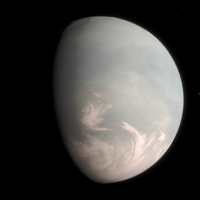 |
≥5.4 | 251 K -22 °C |
0.162 | 0.03 | 16.16 | |||
| 82 G. Eridani b | ≥2.7 | 660 K 387 °C |
0.1207 | 0 | 19.71 | ||||
| 82 G. Eridani c | ≥2.4 | 508 K 235 °C |
0.2036 | 0 | 19.71 | ||||
| 82 G. Eridani d | ≥4.8 | 388 K 115 °C |
0.3499 | 0 | 19.71 | ||||
| Gliese 581 e |  |
≥1.7 | 0.029 | 0 | 20 | ||||
| Gliese 581 c |  |
≥5.6 | 0.072 | 0 | 20 | ||||
| Gliese 581 d |  |
≥5.6 | 2.34 | 1.27 | 233 K -41 °C |
0.218 | 0 | 20 | |
| HD 219134 b |  |
4.5 | 1.6 | 700 K 427 °C |
21 | ||||
| Gliese 667 Cb | 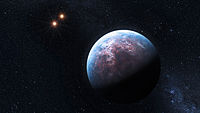 |
6.30 | 1.44 | 445 K 172 °C |
0.05 | 0.09 | 22 | ||
| Gliese 667 Cc |  |
3.8 | 1.32 | 302 K 29 °C |
0.13 | 0.34 | 22 | ||
| 61 Virginis b |  |
≥5.1 | 0.050 | 0.12 | 28 | ||||
| HD 85512 b |  |
≥3.6 | 1.74 | 1.33 | 351 K 78 °C |
0.26 | 0.11 | 36 | |
| GJ 180 b | ≥2.3 | 312 K 39 °C |
38 | ||||||
| TRAPPIST-1b |  |
39.5 | |||||||
| TRAPPIST-1c |  |
39.5 | |||||||
| TRAPPIST-1d | 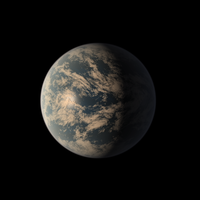 |
282.1 K 9 °C |
39.5 | ||||||
| TRAPPIST-1e |  |
246.1 K -27.1 °C |
39.5 | ||||||
| TRAPPIST-1f |  |
219 K -54 °C |
39.5 | ||||||
| TRAPPIST-1g | 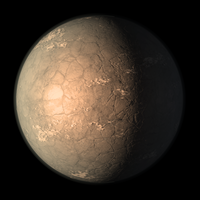 |
198.6 K -75 °C |
39.5 | ||||||
| TRAPPIST-1h |  |
169 K -104 °C |
39.5 | ||||||
| 55 Cancri e (Janssen) |
 |
8.6 | 0.016 | 0.17 | 40 | ||||
| HD 40307 b |
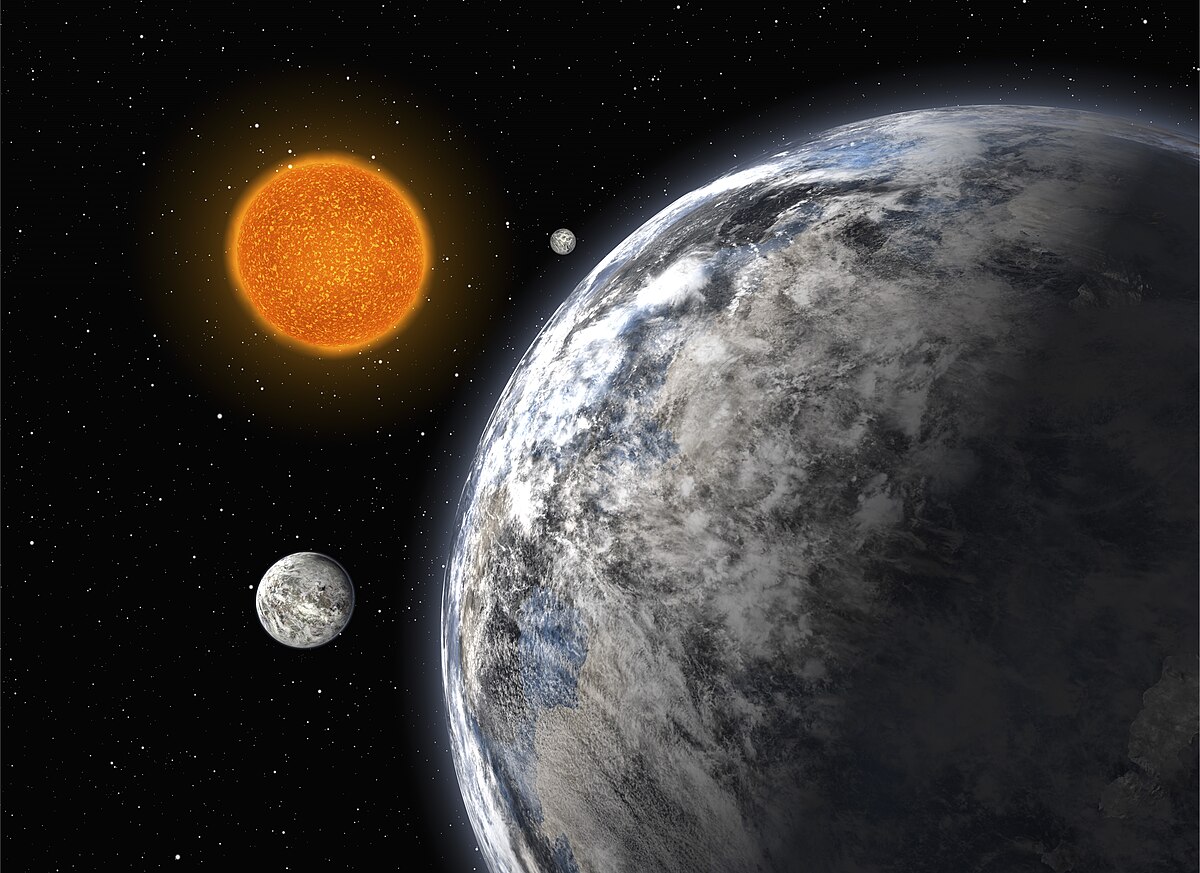

|
≥4.2 | 0.047 | 0.2 | 42 | ||||
| HD 40307 c |


|
≥6.8 | 0.081 | 0.06 | 42 | ||||
| HD 40307 d |  |
≥9.2 | 0.134 | 0.07 | 42 | ||||
| HD 40307 e | ≥3.5 | 0.1886 | 0.15 | 42 | |||||
| HD 40307 f | ≥5.2 | 385 K 112 °C |
0.247 | 0.02 | 42 | ||||
| HD 40307 g | ≥7.1 | 284 K 11 °C |
0.600 | 0.29 | 42 |
Note: There is no scientific consensus about terrestrial composition of most of the planets in the list. Sources in the "Main source" column confirm the possibility of terrestrial composition.
In September 2012, the discovery of two planets orbiting Gliese 163 was announced. One of the planets, Gliese 163 c, about 6.9 times the mass of Earth and somewhat hotter, was considered to be within the habitable zone, but is probably not terrestrial. In May 2016, the finding of three Earth-like planets of ultracool dwarf TRAPPIST-1 has been released.
Statistics
| Distance | Lying within the habitable zone |
All |
|---|---|---|
| < 10 light-years | 0 (2?) | 2 systems |
| < 20 light-years | 6 | 15 |
| < 30 light-years | 8 | 22 |
| < 40 light-years | 10 | 24 |
| < 50 light-years | 11 | 31 |
Note: in most cases the composition of the atmosphere and atmosphere pressure of exoplanets are unknown, so surface temperatures are estimates based on computer models and expert opinions.
See also
- Interstellar travel
- List of exoplanetary host stars
- List of multiplanetary systems
- List of nearest exoplanets
- List of nearest stars and brown dwarfs
- List of potentially habitable exoplanets
- List of Solar twins
References
- ^ Pepe, F.; et al. (2011), "The HARPS search for Earth-like planets in the habitable zone: I – Very low-mass planets around HD20794, HD85512 and HD192310", Astronomy & Astrophysics, 534: A58, arXiv:1108.3447, Bibcode:2011A&A...534A..58P, doi:10.1051/0004-6361/201117055
- ^ Schneider, Jean, "Star: HD 20794", Extrasolar Planets Encyclopaedia, Paris Observatory, retrieved 2011-12-05
- ^ Tuomi, Anglada-Escude, Gerlach, Jones, Reiners, Rivera, Vogt, Butler, Mikko, Guillem, Enrico, Hugh R. R., Ansgar, Eugenio J., Steven S., R. Paul; Anglada-Escude, Guillem; Gerlach, Enrico; Jones, Hugh R. R.; Reiners, Ansgar; Rivera, Eugenio J.; Vogt, Steven S.; Paul Butler, R. (2012). "Habitable-zone super-Earth candidate in a six-planet system around the K2.5V star HD 40307". Astronomy & Astrophysics. 549: A48. arXiv:1211.1617. Bibcode:2013A&A...549A..48T. doi:10.1051/0004-6361/201220268.
{{cite journal}}: CS1 maint: multiple names: authors list (link) - "Stars within 50 light years". Retrieved 3 October 2015.
- "G stars within 100 light-years". Retrieved 3 October 2015.
- ^ Tuomi, Mikko; Jones, Hugh R. A.; Barnes, John R.; Anglada-Escudé, Guillem; Jenkins, James S. (2014). "Bayesian search for low-mass planets around nearby M dwarfs. Estimates for occurrence rate based on global detectability statistics". Monthly Notices of the Royal Astronomical Society. 441 (2): 1545–1569. arXiv:1403.0430. Bibcode:2014MNRAS.441.1545T. doi:10.1093/mnras/stu358.
{{cite journal}}: CS1 maint: unflagged free DOI (link) - ^ Overbye, Dennis (November 4, 2013). "Far-Off Planets Like the Earth Dot the Galaxy". New York Times. Retrieved November 5, 2013.
- ^ Petigura, Eric A.; Howard, Andrew W.; Marcy, Geoffrey W. (October 31, 2013). "Prevalence of Earth-size planets orbiting Sun-like stars". Proceedings of the National Academy of Sciences of the United States of America. 110 (48): 19273–19278. arXiv:1311.6806. Bibcode:2013PNAS..11019273P. doi:10.1073/pnas.1319909110. PMC 3845182. PMID 24191033. Retrieved November 5, 2013.
- Khan, Amina (November 4, 2013). "Milky Way may host billions of Earth-size planets". Los Angeles Times. Retrieved November 5, 2013.
- Anglada-Escudé, Guillem (August 24, 2016). "A terrestrial planet candidate in a temperate orbit around Proxima Centauri" (PDF). Nature. 536 (7617): 437–40. arXiv:1609.03449. Bibcode:2016Natur.536..437A. doi:10.1038/nature19106. PMID 27558064.
- Billings, Lee. "Miniature Space Telescope Could Boost the Hunt for "Earth Proxima"". Scientific American.
- "The Search for Earth Proxima". The Atlantic.
- Anglada-Escudé, Guillem; Amado, Pedro J.; Barnes, John; Berdiñas, Zaira M.; Butler, R. Paul; Coleman, Gavin A. L.; de la Cueva, Ignacio; Dreizler, Stefan; Endl, Michael; Giesers, Benjamin; Jeffers, Sandra V.; Jenkins, James S.; Jones, Hugh R. A.; Kiraga, Marcin; Kürster, Martin; López-González, Marίa J.; Marvin, Christopher J.; Morales, Nicolás; Morin, Julien; Nelson, Richard P.; Ortiz, José L.; Ofir, Aviv; Paardekooper, Sijme-Jan; Reiners, Ansgar; Rodríguez, Eloy; Rodrίguez-López, Cristina; Sarmiento, Luis F.; Strachan, John P.; Tsapras, Yiannis; Tuomi, Mikko; Zechmeister, Mathias (25 August 2016). "A terrestrial planet candidate in a temperate orbit around Proxima Centauri". Nature. 536 (7617): 437–440. arXiv:1609.03449. Bibcode:2016Natur.536..437A. doi:10.1038/nature19106. ISSN 0028-0836. PMID 27558064.
- Wall, Mike (12 April 2019). "Possible 2nd Planet Spotted Around Proxima Centauri". Space.com. Retrieved 22 July 2020.
- https://www.eso.org/public/archives/releases/sciencepapers/eso1837/eso1837a.pdf
- ^ http://phl.upr.edu/projects/habitable-exoplanets-catalog/data
- Fogg, M. J.; Nelson, R. P. (2005). "Oligarchic and giant impact growth of terrestrial planets in the presence of gas giant planet migration". Astronomy and Astrophysics. 441 (2): 791–806. arXiv:astro-ph/0507180. Bibcode:2005A&A...441..791F. doi:10.1051/0004-6361:20053453.
- Rivera, E.; et al. (2005). "A ~7.5 M⊕ Planet Orbiting the Nearby Star, GJ 876". The Astrophysical Journal. 634 (1): 625–640. arXiv:astro-ph/0510508. Bibcode:2005ApJ...634..625R. doi:10.1086/491669.
- Eugenio J. Rivera, Gregory Laughlin, R. Paul Butler, Steven S. Vogt, Nader Haghighipour, Stefano Meschiari (2010). "The Lick-Carnegie Exoplanet Survey: A Uranus-mass Fourth Planet for GJ 876 in an Extrasolar Laplace Configuration".
- http://www.hpcf.upr.edu/~abel/phl/tuomi/hec_orbit_GJ_682_b.png
- ^ "HEC: Data of Potentially Habitable Worlds - Planetary Habitability Laboratory @ UPR Arecibo". Retrieved 3 October 2015.
- "A Nearby Super-Earth with the Right Temperature but Extreme Seasons - Planetary Habitability Laboratory @ UPR Arecibo". Retrieved 3 October 2015.
- ^ Vogt, S. S. (2010). "The Lick-Carnegie Exoplanet Survey: A 3.1 M_Earth Planet in the Habitable Zone of the Nearby M3V Star Gliese 581". The Astrophysical Journal. 723 (1): 954–965. arXiv:1009.5733. Bibcode:2010ApJ...723..954V. doi:10.1088/0004-637x/723/1/954.
- Valencia; Sasselov, Dimitar D.; O'Connell, Richard J. (2007). "Radius and Structure Models of the First Super-Earth Planet". The Astrophysical Journal. 656 (1): 545–551. arXiv:astro-ph/0610122. Bibcode:2007ApJ...656..545V. doi:10.1086/509800.
- von Bloh, W.; Bounama, C.; Cuntz, M.; Franck, S. (2007). "The Habitability of Super-Earths in Gliese 581". Astronomy & Astrophysics. 476 (3): 1365–1371. arXiv:0705.3758. Bibcode:2007A&A...476.1365V. doi:10.1051/0004-6361:20077939.
- ^ The Habitable Exoplanets Catalog. The values are just the best estimates and are subject to change.
- http://phys.org/news/2015-07-astronomers-star-super-earths.html
- Bonfils; Delfosse; Udry; Forveille; Mayor; Perrier; Bouchy; Gillon; Lovis (2011). "The HARPS search for southern extra-solar planets XXXI. The M-dwarf sample". Astronomy. 549: A109. arXiv:1111.5019. Bibcode:2013A&A...549A.109B. doi:10.1051/0004-6361/201014704.
- "A Potential Habitable Exoplanet in a Nearby Triple Star System - Planetary Habitability Laboratory @ UPR Arecibo". Retrieved 3 October 2015.
- Vogt, Steven; Wittenmyer; Paul Butler; Simon O'Toole; Henry; Rivera; Stefano Meschiari; Gregory Laughlin; Tinney (2010). "A Super-Earth and two Neptunes Orbiting the Nearby Sun-like star 61 Virginis". The Astrophysical Journal. 708 (2): 1366–1375. arXiv:0912.2599. Bibcode:2010ApJ...708.1366V. doi:10.1088/0004-637X/708/2/1366.
- Vogt, Steven (2009). \"A Super-Earth and two Neptunes Orbiting the Nearby Sun-like star 61 Virginis
- Kaltenegger, L; Udry, S; Pepe, F (2011). "A Habitable Planet around HD 85512?". 1108: 3561. arXiv:1108.3561. Bibcode:2011arXiv1108.3561K.
{{cite journal}}: Cite journal requires|journal=(help) - Kaltenegger, L.; Udry, S.; Pepe, F. (2011). A Habitable Planet around HD 85512?
- ^ Gillon, M; Triaud, AH; Demory, BO; Jehin, E; Agol, E; Deck, KM; Lederer, SM; de Wit, J; Burdanov, A; Ingalls, JG; Bolmont, E; Leconte, J; Raymond, SN; Selsis, F; Turbet, M; Barkaoui, K; Burgasser, A; Burleigh, MR; Carey, SJ; Chaushev, A; Copperwheat, CM; Delrez, L; Fernandes, CS; Holdsworth, DL; Kotze, EJ; Van Grootel, V; Almleaky, Y; Benkhaldoun, Z; Magain, P; Queloz, D (2017). "Seven temperate terrestrial planets around the nearby ultracool dwarf star TRAPPIST-1" (PDF). Nature. 542 (7642): 456–460. arXiv:1703.01424. Bibcode:2017Natur.542..456G. doi:10.1038/nature21360. PMC 5330437. PMID 28230125.
- Rebekah; et al. (2010). "Radial velocity planets de-aliased. A new, short period for Super-Earth 55 Cnc e". The Astrophysical Journal. 722 (1): 937–953. arXiv:1005.4050. Bibcode:2010ApJ...722..937D. doi:10.1088/0004-637x/722/1/937.
- ^ M. Mayor; S. Udry; C. Lovis; F. Pepe; D. Queloz; W. Benz; J.-L. Bertaux; F. Bouchy; C. Mordasini; D. Segransan (2009). "The HARPS search for southern extra-solar planets. XIII. A planetary system with 3 Super-Earths (4.2, 6.9, & 9.2 Earth masses)". Astronomy and Astrophysics. 493 (2): 639–644. arXiv:0806.4587. Bibcode:2009A&A...493..639M. doi:10.1051/0004-6361:200810451.
- Barnes, R., Jackson, B., Raymond, S., West, A., Greenberg, R. (2009). "The HD 40307 Planetary System: Super-Earths or Mini-Neptunes?". The Astrophysical Journal. 695 (2): 1006–1011. arXiv:0901.1698. Bibcode:2009ApJ...695.1006B. doi:10.1088/0004-637X/695/2/1006.
{{cite journal}}: CS1 maint: multiple names: authors list (link) - "HEC: Data of Potential Habitable Worlds". University of Puerto Rico at Arecibo (Planetary Habitability Laboratory). November 12, 2012.
- Staff (September 20, 2012). "LHS 188 -- High proper-motion Star". Centre de données astronomiques de Strasbourg(Strasbourg astronomical Data Center). Retrieved September 20, 2012.
- ^ Méndez, Abel (August 29, 2012). "A Hot Potential Habitable Exoplanet around Gliese 163". University of Puerto Rico at Arecibo (Planetary Habitability Laboratory). Retrieved September 20, 2012.
- ^ Redd, Nola Taylor (September 20, 2012). "Newfound Alien Planet a Top Contender to Host Life". Space.com. Retrieved September 20, 2012.
